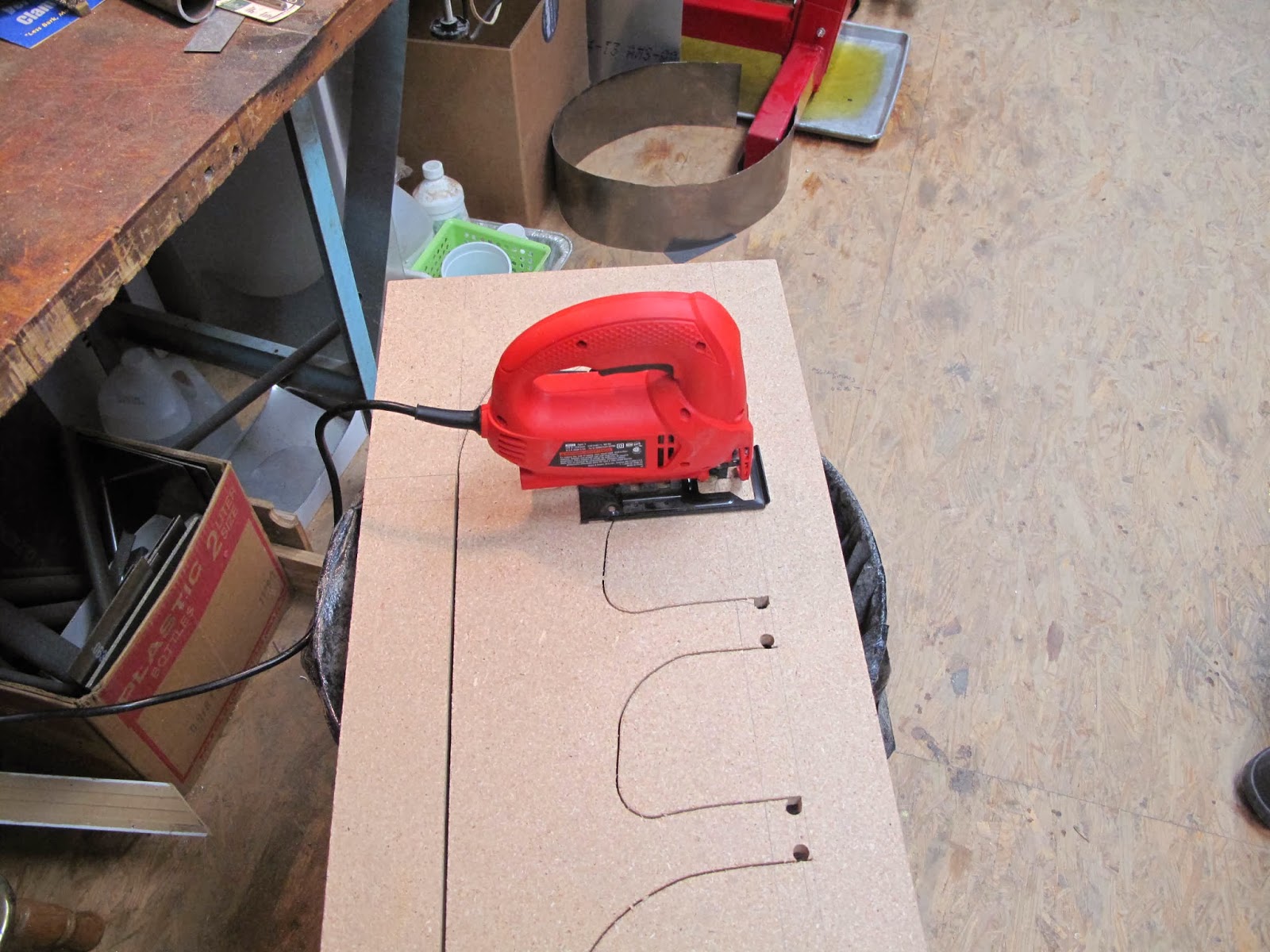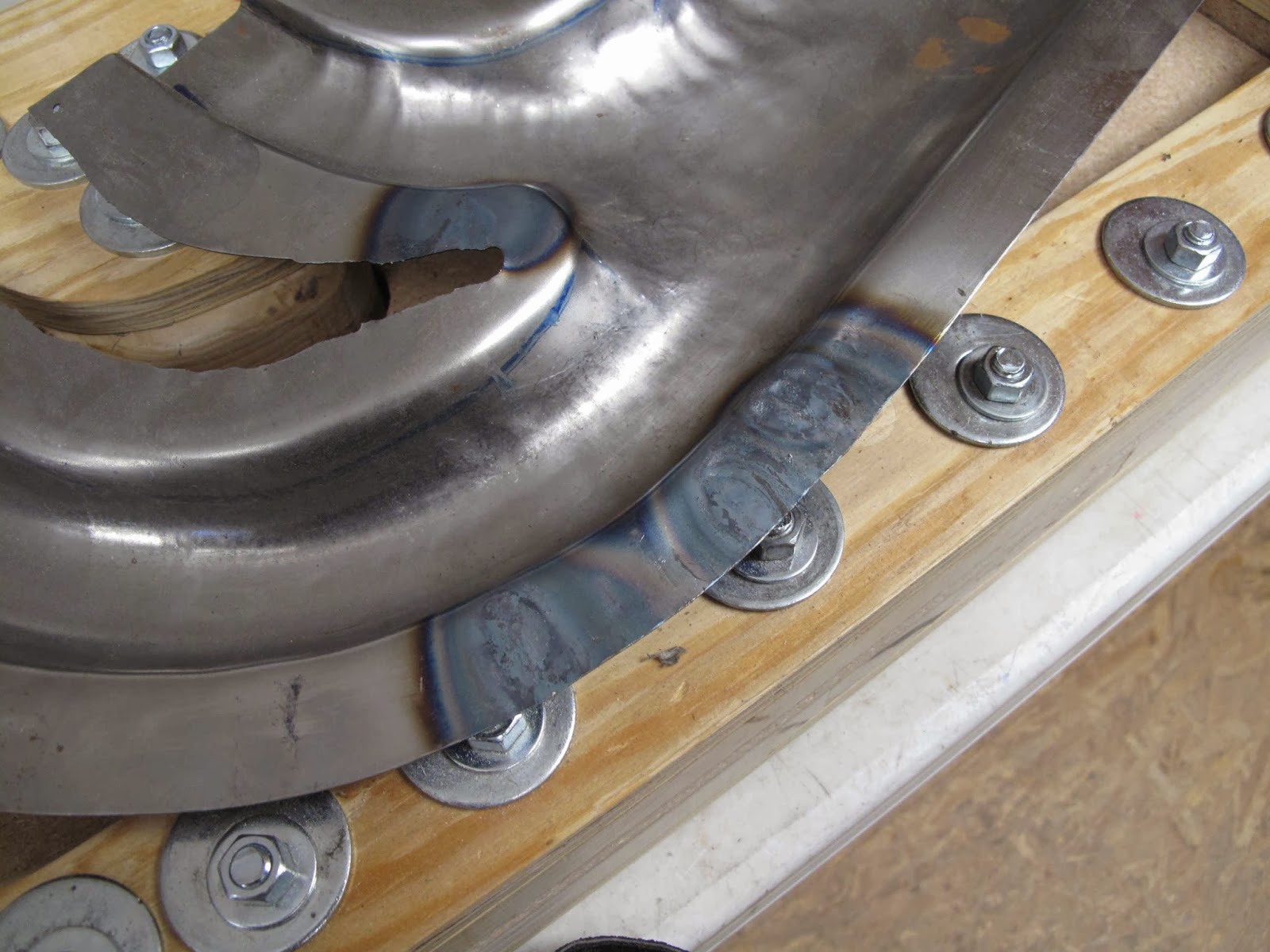The original form block is still making good parts, but several people asked me about making manifolds for their engines. There are some changes I wanted to make to improve the process so this seemed a good time to make a new form block. The changes are small, like some added length to the inlet ends, better bolt locations and the use of hardwood for the outer (working) layers. I also only waxed the radii the metal slides on during forming to hopefully get a better grip on the flanges.
The center layer is made in the same manner as the original block. The opening was drawn with the template.
Holes were drilled at the corners to make it easier to cut with the saber saw.
The straight edge was cut on the table saw to get a nice straight edge.
The other cuts were made with the saber saw. The cut out piece will be used later to fill the hole to prevent over forming the shell.
With the hole cut out the hole was carefully filed and sanded to fit the template.
Instead of using particle board for the working layers I purchased some ash form a local saw mill and planned it to about 1" thick, just enough to clean it up.
As the boards were added the grain was aligned to have the steel slide with the grain to give the strongest edges to the block. You can faintly see my direction arrows on the center board.
The pieces were cut to leave a rough opening as was done with the particle board block so they could be matched to the center board with the router once all the pieces were glued on.
As pieces were added the corners were carefully cleaned of glue so each new piece could be tightly clamped in place.
Along with clamps to provide glue pressure cross clamps were used to tightly fit the pieces.
Once the block was glued the faces and edges were belt sanded to clean the up, and the corners were rounded.
The opening was then matched to the center board with a 1" Formica router bit and the 3/8" radius routed on the corners as on the original block.
The radii were waxed with 2 coats of Trewax (Carnauba paste wax).
The washers were positioned to work out the locations of the clamping bolts. No additional changes were made to the shape of the blank.
The bolts were positioned close to the blank to get the best clamping pressure.
Because the block was so heavy I started all the holes with a 4 1/2 center drill. It was just too hard to get the drill properly centered on the center punch mark. With a starter hole it was easy to see the drill was aligned properly before drilling.
The drill table was carefully squared using a piece of 3/8" rod before drilling with a drill 1/64" larger than the 3/8" bolts.
A piece of 3/4" plywood was again used on the bottom of the block and for the clamping board on top. Because the drill press was very square the top and bottom boards can be switched to make the 2 halves and all the bolts fit perfectly.
The center cut out piece is also used as part of the filler.
For the square inlets blocks of ash were made made to allow the steel to be hammered into shape with the modified 1 1/8" bolt. The radius on the right end it to provide a smooth transition from the square section to round. The 4 blocks just set in the inlet ends. The backing block (center scraps holds them in place).
They are numbered because they are each slightly different to fit the shape of each inlet.
The manifold thickness tapers form inlet to outlet so I used the center scraps to make a backing block to better control the shape. I tapered the plywood piece with the belt sander.
The tapered plywood piece goes in the bottom with the particle board piece on top. It the particle board piece gets broken from pounding it's the cheapest and easiest to replace. It also make a nice surface to pound on.
The new form block is now ready for some steel.
There are a couple spots where wrinkles form. I've been hammering them cold to shrink them. I realized they would shrink better hot. I just heated the hump with the torch to red hot and then a quick blow with the hammer does the trick.
Because I used the template to make both the old and new blocks, the openings are so close to the same shape I was able to take a part I had started on the old block and finish it in the new block. Here it is ready for finishing.
Back to making shells!































No comments:
Post a Comment